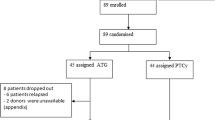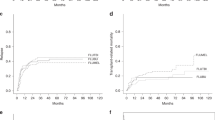Abstract
Purine analogs are often used for conditioning preceding allogeneic hematopoietic stem cell transplantation (HCT). We prospectively tested fludarabine (Flu) 40 mg/m2/day × 5 days vs cladribine (Clad) 10 mg/m2/day × 5 days plus oral busulfan (1 mg/kg q6 h × 2 days) and total body irradiation 200 cGy in 32 recipients of matched sibling and unrelated donor (URD) HCT. Patients were similar in age (median 52 years), diagnosis, extensive pre-HCT therapy (56 vs 63%), and high-risk disease status (81 vs 93%). Neutrophil engraftment was prompt (median 11 vs 12 days), but early graft failure using Clad halted randomization. Platelet recovery was prompt (median Flu 18 vs Clad 24 days). Graft-versus-host disease (GVHD) after Flu vs Clad was similar; (acute grade II/IV 56 vs 69%, P=0.26; chronic 50 vs 31%, P=0.27). Nonrelapse mortality (Flu 25 vs Clad 38%, P=0.47) and progression-free survival at 3 years were similar as well. Multivariate analyses showed slightly, but not significantly lower relative risk (RR) of neutrophil engraftment with Clad (RR 0.6 (95% CI 0.2–1.3) P=0.16) and with URD RR 0.4 (0.2–1.0) P=0.04). Older patients with advanced hematologic malignancies achieve satisfactory outcomes using either of these reduced intensity conditioning regimens.
This is a preview of subscription content, access via your institution
Access options
Subscribe to this journal
Receive 12 print issues and online access
$259.00 per year
only $21.58 per issue
Buy this article
- Purchase on Springer Link
- Instant access to full article PDF
Prices may be subject to local taxes which are calculated during checkout



Similar content being viewed by others
References
Khouri IF, Keating M, Korbling M, Przepiorka D, Anderini P, O'Brien S et al. Transplant-lite: induction of graft-versus-malignancy using fludarabine-based nonablative chemotherapy and allogeneic blood progenitor-cell transplantation as treatment for lymphoid malignancies. J Clin Oncol 1998; 16: 2817–2824.
Slavin S, Nagler A, Naparstek E, Kapelushnik Y, Aker M, Cividalli G et al. Nonmyeloablative stem cell transplantation and cell therapy as an alternative to conventional bone marrow transplantation with lethal cytoreduction for the treatment of malignant and nonmalignant hematologic diseases. Blood 1998; 91: 756–763.
Giralt S, Thall PF, Khouri I, Wang X, Braunschweig I, Ippolitti C et al. Melphalan and purine analog-containing preparative regimens: reduced-intensity conditioning for patients with hematologic malignancies undergoing allogeneic progenitor cell transplantation. Blood 2001; 97: 631–637.
McSweeney PA, Niederwieser D, Shizuru JA, Sandmaier BM, Molina AJ, Maloney DG et al. Hematopoietic cell transplantation in older patients with hematologic malignancies: replacing high-dose cytotoxic therapy with graft-versus-tumor effects. Blood 2001; 97: 3390–3400.
Bornhauser M, Thiede C, Schuler U, Platzbecker U, Freiberg-Richter J, Helwig A et al. Dose-reduced conditioning for allogeneic blood stem cell transplantation: durable engraftment without antithymocyte globulin. Bone Marrow Transplant 2000; 26: 119–125.
Michallet M, Bilger K, Garban F, Attal M, Huyn A, Blaise D et al. Allogeneic hematopoietic stem-cell transplantation after nonmyeloablative preparative regimens: impact of pretransplantation and posttransplantation factors on outcome. J Clin Oncol 2001; 9: 3340–3349.
Chakraverty R, Peggs K, Chopra R, Milligan D, Kottaridis PD, Verfuerth S et al. Limiting transplantation-related mortality following unrelated donor stem cell transplantation by using a nonmyeloablative conditioning regimen. Blood 2002; 99: 1071–1078.
Corradini P, Tarella C, Olivieri A, Gianni AM, Voena C, Zayillo F et al. Reduced-intensity conditioning followed by allografting of hematopoietic cells can produce clinical and molecular remissions in patients with poor-risk hematologic malignancies. Blood 2002; 99: 75–82.
Robinson SP, Goldstone AH, Mackinnon S, Carell A, Russell N, de Elvira C et al. Chemoresistant or aggressive lymphoma predicts for a poor outcome following reduced-intensity allogeneic progenitor cell transplantation: an analysis from the Lymphoma Working Party of the European Group for Blood and Bone Marrow Transplantation. Blood 2002; 100: 4310–4316.
Niederwieser D, Maris M, Shizuru JA, Petersdorf E, Hegenbart U, Sandmaier BM et al. Low-dose total body irradiation (TBI) and fludarabine followed by hematopoietic cell transplantation (HCT) from HLA-matched or mismatched unrelated donors and postgrafting immunosuppression with cyclosporine and mycophenolate mofetil (MMF) can induce durable complete chimerism and sustained remissions in patients with hematological diseases. Blood 2003; 101: 1620–1629.
Bacigalupo A . Second EBMT Workshop on reduced intensity allogeneic hemopoietic stem cell transplants (RI-HSCT). Bone Marrow Transplant 2002; 29: 191–195.
Gooley TA, Leisenring W, Crowley J, Storer BE . Estimation of failure probabilities in the presence of competing risks: new representations of old estimators. Statist Med 1999; 18: 695–706.
Kaplan EL, Meier P . Nonparametric estimator from incomplete observations. J Am Statist Assoc 1958; 53: 457–481.
Cox DR . Regression models and life tables (with discussion). J Roy Statist Soc 1972; 34: 187–220.
Douek DC, Vescio RA, Betts MR, Brenchley JM, Hill BJ, Zhang L et al. Assessment of thymic output in adults after haematopoietic stem cell transplantation and prediction of T-cell reconstitution. Lancet 2000; 355: 1875–1881.
Baron F, Maris MB, Sandmaier BM, Storer BE, Sorror M, Diaconescu R et al. Graft-versus-tumor effects after allogeneic hematopoietic cell transplantation with nonmyeloablative conditioning. J Clin Oncol 2005; 23: 1993–2003.
Khouri IF, Saliba RM, Giralt SA, Lee MS, Okoroji GJ, Hagemeister FB et al. Nonablative allogeneic hematopoietic transplantation as adoptive immunotherapy for indolent lymphoma: low incidence of toxicity, acute graft-versus-host disease, and treatment-related mortality. Blood 2001; 98: 3595–3599.
Or R, Shapira MY, Resnick I, Amar A, Ackerstein A, Samuel S et al. Nonablative allogeneic stem cell transplantation for the treatment of chronic myeloid leukemia in first chronic phase. Blood 2003; 101: 441–445.
Jimenez M, Martinez C, Ercilla G, Carreras E, Urbano-Ispizua A, Aymerich M et al. Reduced-intensity conditioning regimen preserves thymic function in the early period after hematopoietic stem cell transplantation. Exp Hematol 2005; 33: 1240–1248.
Author information
Authors and Affiliations
Corresponding author
Rights and permissions
About this article
Cite this article
Markova, M., Barker, J., Miller, J. et al. Fludarabine vs cladribine plus busulfan and low-dose TBI as reduced intensity conditioning for allogeneic hematopoietic stem cell transplantation: a prospective randomized trial. Bone Marrow Transplant 39, 193–199 (2007). https://doi.org/10.1038/sj.bmt.1705556
Received:
Revised:
Accepted:
Published:
Issue Date:
DOI: https://doi.org/10.1038/sj.bmt.1705556



